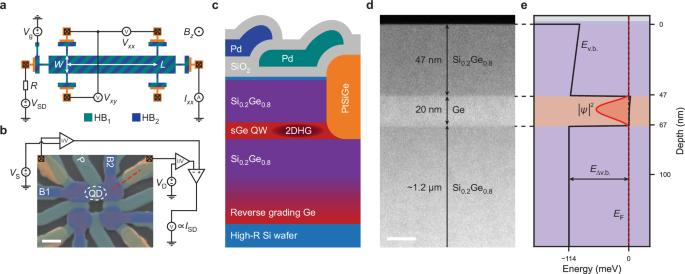界面陷阱对 Ge/SiGe 异质结构中电荷噪声和低密度传输特性的影响
IF 7.5
Q1 MATERIALS SCIENCE, MULTIDISCIPLINARY
引用次数: 0
摘要
Ge/SiGe 异质结构中的空穴自旋已成为一种有趣的量子位平台,具有快速电控制和在甜点处抗噪声运行等有利特性。然而,通常观察到的栅极诱导的静电紊乱、漂移和滞后阻碍了基于硅锗的量子点阵列的可重现性调整。在这里,我们研究了在 Ge/SiGe 异质结构上制造的霍尔条和量子点器件,并提出了一个关于栅极滞后的起源及其对传输指标和电荷噪声影响的一致模型。当我们将累积电压推向更负的位置时,我们观察到低密度传输指标的非单调变化,这归因于在硅锗-氧化物界面上电荷阱空间密度变化的诱导性逐渐填充。每推动一次栅极电压,我们都会发现瞬时低频电荷噪声分量的局部激活,30 小时后该分量又会完全消失。我们的研究结果凸显了锗硅材料平台对界面阱引起的无序和噪声的适应能力,并为更大的多点系统的可重现调谐铺平了道路。硅锗量子点阵列中的空穴自旋是一种很有前途的量子位平台,但却受到栅极诱导的静电紊乱、漂移和滞后的影响。这里研究了霍尔条和量子点 Ge/SiGe 异质结构,获得了栅极滞后模型及其对传输和电荷噪声的影响。本文章由计算机程序翻译,如有差异,请以英文原文为准。

Impact of interface traps on charge noise and low-density transport properties in Ge/SiGe heterostructures
Hole spins in Ge/SiGe heterostructures have emerged as an interesting qubit platform with favourable properties such as fast electrical control and noise-resilient operation at sweet spots. However, commonly observed gate-induced electrostatic disorder, drifts, and hysteresis hinder reproducible tune-up of SiGe-based quantum dot arrays. Here, we study Hall bar and quantum dot devices fabricated on Ge/SiGe heterostructures and present a consistent model for the origin of gate hysteresis and its impact on transport metrics and charge noise. As we push the accumulation voltages more negative, we observe non-monotonous changes in the low-density transport metrics, attributed to the induced gradual filling of a spatially varying density of charge traps at the SiGe-oxide interface. With each gate voltage push, we find local activation of a transient low-frequency charge noise component that completely vanishes again after 30 hours. Our results highlight the resilience of the SiGe material platform to interface-trap-induced disorder and noise and pave the way for reproducible tuning of larger multi-dot systems. Hole spins in SiGe quantum dot arrays are a promising qubit platform, but suffer from gate-induced electrostatic disorder, drift and hysteresis. Here, Hall bar and quantum dot Ge/SiGe heterostructures are studied, obtaining a model for gate hysteresis and its effect on transport and charge noise.
求助全文
通过发布文献求助,成功后即可免费获取论文全文。
去求助
来源期刊

Communications Materials
MATERIALS SCIENCE, MULTIDISCIPLINARY-
CiteScore
12.10
自引率
1.30%
发文量
85
审稿时长
17 weeks
期刊介绍:
Communications Materials, a selective open access journal within Nature Portfolio, is dedicated to publishing top-tier research, reviews, and commentary across all facets of materials science. The journal showcases significant advancements in specialized research areas, encompassing both fundamental and applied studies. Serving as an open access option for materials sciences, Communications Materials applies less stringent criteria for impact and significance compared to Nature-branded journals, including Nature Communications.
 求助内容:
求助内容: 应助结果提醒方式:
应助结果提醒方式:


